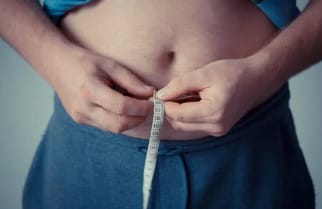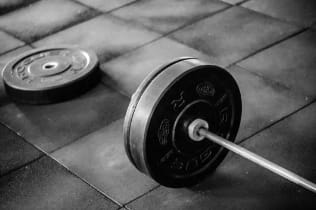Do you find yourself endlessly chasing that coveted six-pack, only to be met with frustration and disappointment? You're not alone. A staggering 92% of individuals struggle to unveil their abs, falling victim to common mistakes that keep their core under wraps. In this article, we'll unravel the mystery behind why most fitness enthusiasts miss the mark and provide you with the ultimate guide to transform your core. If you're tired of the ab secrecy and ready to crack the code, this article is your key to success.
Here is what we will be covering:
· Patience Pays Off
· Commitment Over Perfection
· Adjust and Adapt

Only a small fraction of guys, around 8%, in the U.S. flaunt those coveted six-pack abs, according to data from the Fitness Institute of America. Some studies push the estimate up to 10%, but here's the kicker—most men carry a body fat percentage that's a tad too high for their abs to make an appearance. With only 3 to 5% of the population maintaining the sweet spot between 6 and 13%, where abs come into play, it's no wonder those washboard stomachs are a rare sight. Now, let's get real. Nearly everyone tuning in has the potential for killer abs. The catch? Many make critical mistakes that keep those abdominal muscles in hiding.
Low Body Fat
First up, impatience takes the stage. Visible abs demand a relatively low body fat percentage, typically under 13 to 15%. The hitch? Very few hit that mark because, let's face it, the belly area is a slow fat-burning zone. It's your body's stash spot, and patience is the key. Your face, arms, and legs might shed fat first, leaving the abs for the grand finale. So, buckle up for the long haul—stick to a calorie deficit, eat right, and let time work its magic.

Patience
But here's where many falter—an all-or-nothing attitude. As the saying goes, Rome wasn't built in a day, and neither are six-pack abs. People get disheartened when the journey takes longer than expected, leading to diet slips or, worse, throwing in the towel. Guess what? Every time you abandon ship, you set yourself back. The belly is quick to accumulate fat when you regain it. So, commitment is the name of the game. Stay in that calorie deficit, eat mindfully, and watch as your body finally dips into that stored belly fat.
Now, onto another plot twist—failing to readjust your diet plan as you burn fat and get leaner. Most folks calculate their calorie deficit at the diet's kickoff, but as you shed the pounds, things shift. Carrying more body fat gives your metabolism a boost. Lose some muscle, and adaptive thermogenesis steps in, slowing your resting metabolic rate. So, when the fat loss hits a plateau (and it will), don't stick to the old plan like a lifeline. Adjust your calories and macros—give your body a new challenge. Plateaus call for a fresh perspective, not a stubborn standstill.

Genetics
Let's dive into a crucial aspect often overlooked on the road to chiseled abs—one that's beyond your control: genetics. Yes, the six-pack struggle has its roots in the very fabric of your being—the rectus abdominis. This abdominal muscle, commonly known as the six-pack, is a single sheet rather than the six distinct muscles it appears to be. Blame it on tendinous inscriptions—those tendons running in between the rectus abdominis. Here's the kicker: genetics dictate the number, size, and even lopsided arrangements of these inscriptions. That's why your buddy might boast symmetrical abs, while you're rocking a four-pack with the same body fat percentage. Your goal? Not an 8 or 10-pack, but a lean physique that unveils your unique abdominal structure.

Progressive Overload
Now, let's shift gears to something fully within your control—building those abs. Here's a major faux pas I see: guys hitting the gym, pumping iron for squats and bench presses, yet treating their abs with kid gloves. Your rectus abdominis craves heavy loads, just like any other muscle. Progressive overload is the name of the game. Besides trimming body fat, you can enhance visibility by growing your ab muscles. Developed abs make a grand entrance, unlike their undertrained counterparts. So, every week, aim to lift heavier weights during ab exercises—think weighted decline sit-ups, leg raises, and crunches. Opt for multiple sets with six to ten reps, steering clear of endless bodyweight crunches.
Don't fall into the compound exercise trap. While squats and deadlifts are gym staples, relying solely on them won't sculpt those abs. Research spills the beans: direct ab exercises like straight leg sit-ups beat the heavyweight champs in activating the rectus abdominis. Tackle your ab game head-on with specific exercises—weighted decline sit-ups, leg raises with pulse-ups and weighted crunches. Watch that weight load climb, and let your abs steal the spotlight.

Volume
Train those abs at least twice a week, knocking out a solid nine-weighted set each time. Here's the thing: many miss the mark, tossing in a few crunches as an afterthought, leaving their ab training in the dust. Volume is the name of the game, and it's not just about reps. It's the total sets, reps, and that weight load you're pushing. Studies spill the beans: hitting those abs twice a week trumps the once-a-week approach. Muscle growth thrives on it.
But here's a crucial pitfall—no daily ab marathons. Abs need recovery, just like your shoulders, legs, etc. Two to three focused ab workouts a week, with some serious weight in the mix, is the sweet spot. Avoid the trap of ditching crunches for static planks. The fear that crunches lead to lower back pain? Debunked. Your rectus abdominis craves flexion and extension dance in exercises like decline sit-ups and crunches.
Let's clear the air—abs aren't the exception to the rule. Just as you wouldn't half-curl to sculpt biceps, don't shortchange those abs. Embrace the full range of motion, concentrate on form, and nix the neck-pulling theatrics. Your spine will thank you.
Bottom line? Body fat is the silent saboteur. If it's playing hide-and-seek with your abs, no amount of crunches will make them pop.
Source: Gravity Transformation
